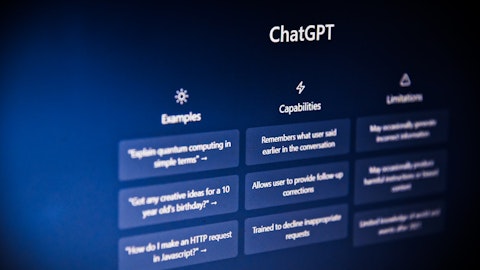So the people who are trying are loving it, we have to document our successes we have to create the blueprint. We have to train the partners. So there’s a, let’s say, any way you look at it, you’re looking at a six to nine-month lag in that, going from one to the other. And that’s the way we look at it. So we’re seeing very good early traction and that early traction to convert to steady predictable growth on the bookings side. I think that’s probably the two quarters or three that we need.
Matt VanVliet: Okay. Thanks for taking the questions.
Ragy Thomas: Absolutely.
Operator: Thank you. Our next question comes from the line of Brett Knoblauch with Cantor Fitzgerald. Please proceed with your question.
Brett Knoblauch: Thanks guys. Congrats on the strong quarter. I guess last quarter, you flagged some very large deals with some of your largest customers and said that those kind of contract values were up 10%, 15% or double digit. But it seems like this quarter, large customers are more of a headwind. So I guess is there a bifurcation of, I guess, in terms of the type of customer? Maybe the industry of that customer that is expanding versus downsell?
Ragy Thomas: Yeah, these are two different bases, right? So some of the downsell pressure we’re talking about sort of the marketing side and advertising side. And the other thing to put in perspective, we did land some large implementations in contracts sort of brand-wise, size-wise, on CCaaS, we will continue to do so. The thing though is there is, they go market by market, right? So these are companies, in many cases, they have executed a master agreement, but then you go market by market, and you’ll start seeing those bookings and revenues only as markets come on board. And these markets are on different contract timing cycles, right? So you might have a set of markets in LatAm, whose renewal with their current solution is coming up in six months or nine months.
It’s actually good for us because these early implementations the [99, the 59] (ph) uptimes and a whole bunch of things that we are just working through the system we’ve done it before, that it’s good to have that breathing room. So I just want to make sure that you understand the time lapse as you take those snapshots and try to put it together. And that should, once the base is established through the rest of this year and next year, we should see that pipeline convert steadily, but you’re going to see a little bit of a starting lag.
Brett Knoblauch: Understood. Makes sense. And then maybe just on your kind of like net revenue retention and how we should think about that going forward. I guess to get to maybe the 10% growth that you guys were talking about next year, seems like that’s going to fall pretty sharply. Is that something that we should expect to maybe end ’25 below [110?] (ph)
Manish Sarin: Yeah, this is Manish. So I have never given a number for net dollar expansion or retention. As I state on every earnings call, it’s a byproduct of what’s happening in the business. We have signaled even in the past, we do expect the 118% to keep coming down. I don’t know where it’s going to end up, but I think you can use the total revenue guide. You can use the billings number for next year to sort of know that it is going to come down from the 118% probably maybe not very different from where you were expecting, but it’s not something that I formally put out a number on.
Brett Knoblauch: Got it. And then maybe if I could just ask one more on the expense side, particularly with marketing, it looks like kind of cash-based sales and marketing expenses are down a good bit in the first quarter. I guess how should we think about expense growth while you go through this go-to-market transition?
Manish Sarin: I think at this point, we will probably provide more color in the March earnings call for next year. I did want to point out that non-GAAP operating margins ought to expand from here. So there will be more efficiencies across the business. I don’t want to specifically call out for sales and marketing. But I think as Ragy answered in one of the other questions, we’re not looking to incrementally invest a lot more. I think it’s more around reallocation of existing resources.
Ragy Thomas: Yeah. I mean, and this might be premature. But look, we just I started the call by saying one should expect 20% to 40% productivity gains in the front office. And look, we intend, and let me be specific, I intend for us to be client zero. So there’s a lot of things that we’re doing now. That’s going to take a few quarters. That it’s just like we’re going to eat our own dog food or drink our own champagne here. And so look, we’re anticipating and working towards improving productivity. So I think I echo Manish’s sentiment that we should be able to do both.
Brett Knoblauch: Perfect. Thank you guys. Appreciate it.
Operator: Thank you. Question comes from the line of Michael Berg with Wells Fargo. Please proceed with your question.
Michael Berg: Hi, thanks for taking my question. I wanted to ask, going back to CCaaS. When you think of the sales process for your CCaaS offering is primarily in the application layer. You do have the voice capabilities now. But maybe more holistically, how do you think about that piece of the business progressing to doing more, at least with how I imagine, augmentations today to more strategic holistic [indiscernible] at least that’s becoming more of a norm. Thank you.
Ragy Thomas: Sorry, Michael, can you, what was your question? Is it, can you repeat the question? I’m not sure I got it.
Michael Berg: Absolutely. I guess how do you think about the progression of and CCaaS moving from being an augmentation into more of the digital application layer within a CCaaS deployment being a more holistic strategic replacement of the legacy vendors from end to end moving forward? Or I guess, I guess what inning are you in that transition? Thank you.




